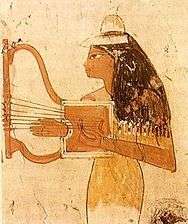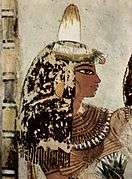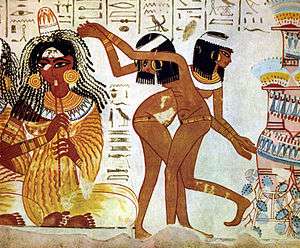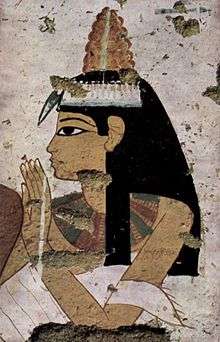Head cone
Head cones were a type of conical ornament worn atop the head in Ancient Egypt. They are often depicted on paintings and bas-reliefs of the era, but were not found as archaeological evidence until 2019.[1][2]

Function
Perfume cones were presumably made of a mixture of oils, resins and fat, and containing myrrh. Images of the era show people wearing them on wigs or on shaved heads. The slow melting of the cones due to bodily heat would have spread the fragrance.[3]
Depiction
The first known depiction of the perfume cones dates from the reign of Hatshepsut, in scenes of banquet or funeral. Form then on, they are often seen in scenes of worship and funerals. From the Third Intermediate Period, their depiction is limited to scene of worship.
The shape of the cones varies over the 18th and 19th Dynasties, which constitutes an aid for dating the works. From the 20th Dynasty onwards, the depiction of the cones becomes schematic.[4]
 Musician playing the lyra with a perfum cone
Musician playing the lyra with a perfum cone Woman wearing a perfume cone, circa 1422–1411 BCE
Woman wearing a perfume cone, circa 1422–1411 BCE Musician wearing a perfum cone, circa 1400 BCE
Musician wearing a perfum cone, circa 1400 BCE Woman wearing a perfume cone, 1350–1300 BCE
Woman wearing a perfume cone, 1350–1300 BCE Priest Renpetmaa wearing a perfum cone, worshipping Re-Harachte, circa 900 BCE
Priest Renpetmaa wearing a perfum cone, worshipping Re-Harachte, circa 900 BCE
Notes and references
Notes
- "New Evidence Suggests Ancient Egyptian Head Cones Were Real". Gizmodo. Retrieved 2020-02-11.
- "Ancient Egyptian 'head cone mystery' solved by archaeologists". History. 2019-12-11. Retrieved 2020-02-11.
- Rainer Hannig, p.258
- Monika Silke Randl
Biblliography
- Rainer Hannig: Großes Handwörterbuch Ägyptisch-Deutsch: (2800-950 v. Chr.). von Zabern, Mainz 2006, ISBN 3-8053-1771-9, p. 258.
- Monika Silke Randl: Die Entwicklung der Salbkegel im Flachbild. Diplomarbeit, Universität Wien 2008